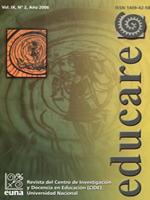Representaciones gráficas de niños y niñas de preescolar, segundo y cuarto grado, con y sin necesidades educativas especiales
DOI:
https://doi.org/10.15359/ree.9-2.3Abstract
This research on the body parts concept held by children with and without special needs from preschool, second and fourth grade provides data about their graphic representations of body parts.
In both groups, most students made accurate representations of their body image, but the drawings of one large group of students with special needs from all three grades show characteristics below those expected for children in their age range. Another small group of students with and without special needs from preschool and second grade made drawings with characteristics beyond those expected for their age.
We suggest that all educational processes take into account students’ previous knowledge and emphasize not only the teaching of body-related concepts but also concepts related to body image. Teaching activities must also allow students to experience and construct the studied concepts.
References
Cristofanelli, P. (s.f.-a). Mundo Garabato: los niños y la grafología ( 1 ). La postura de los adultos frente al garabato y el dibujo infantiles. En línea: http://www.naturino.com/esp/grafologial_es.htm
Cristofanelli, P. (s.f.-b). Mundo Garabato: los niños y la grafología (2). Garabato/Dibujo espontáneo: instrumento de formación y medio de comunicación. En línea: http://www.naturino.com/esp/grafologia2_es.htm
Fontana, A.; Pereira, Z. y Rojas, D. (2005). El concepto de esquema corporal desde la perspectiva de niños de O a 1 O años, con y sin necesidades educativas especiales. Informe final de investigación. Heredia: División de Educación Básica, Universidad Nacional.
Geocities. (s.f.). Las etapas del grafismo. En línea: http://es.geocities.com/ishar20/las_etapas_del_grafismo.htm
Hemández, E. (s.f.). El dibujo infantil (parte]). La etapa del garabateo: de 2 a 4 años. En línea: http://www.tupediatra.com/mnyy/adaptacion-conductas/mnyy4 l .htm
Jerez, A. (s.f.). "Las vanguardias del siglo XX en relación con el dibujo infantil". En: Revista Andaluza de Arte. Alonso Cano. Nº 5. En línea: http://person.wanadoo.es
Langford, P. ( 1989). El desarrollo del pensamiento conceptual en la escuela primaria.Barcelona: Editorial Paidós.
Lowenfeld, V. (1961). Desarrollo y capacidad creadora. Buenos Aires: Kapelusz.
Lowenfeld, V. (1973). El niño y su arte. Buenos Aires: Kapelusz.
Tiraferri, L. (s.f.). Dime qué dibujas ... y sabré qué sientes. En línea: http://educacion.1243.cl/papas/cero_drama/que_diujas.htm
Downloads
Published
How to Cite
Issue
Section
License
1. In case the submitted paper is accepted for publication, the author(s) FREELY, COSTLESS, EXCLUSIVELY AND FOR AN INDEFINITE TERM transfer copyrights and patrimonial rights to Universidad Nacional (UNA, Costa Rica). For more details check the Originality Statement and Copyright Transfer Agreement
2. REUTILIZATION RIGHTS: UNA authorizes authors to use, for any purpose (among them selfarchiving or autoarchiving) and to publish in the Internet in any electronic site, the paper´'s final version, both approved and published (post print), as long as it is done with a non commercial purpose, does not generate derivates without previous consentment and recognizes both publisher's name and authorship.
3. The submission and possible publication of the paper in the Educare Electronic Journal is ruled by the Journal’s editorial policies, the institutional rules of Universidad Nacional and the laws of the Republic of Costa Rica. Additionally, any possible difference of opinion or future dispute shall be settled in accordance with the mechanisms of Alternative Dispute Resolution and the Costa Rican Jurisdiction.
4. In all cases, it is understood that the opinions issued are those of the authors and do not necessarily reflect the position and opinion of Educare, CIDE or Universidad Nacional, Costa Rica. It is also understood that, in the exercise of academic freedom, the authors have carried out a rogorous scientific-academic process of research, reflection and argumentation thar lays within the thematic scope of interest of the Journal.
5. The papers published by Educare Electronic Journal use a Creative Commons License:














 The articles published by Educare Electronic Journal can be shared with a Creative Commons License:
The articles published by Educare Electronic Journal can be shared with a Creative Commons License: 



